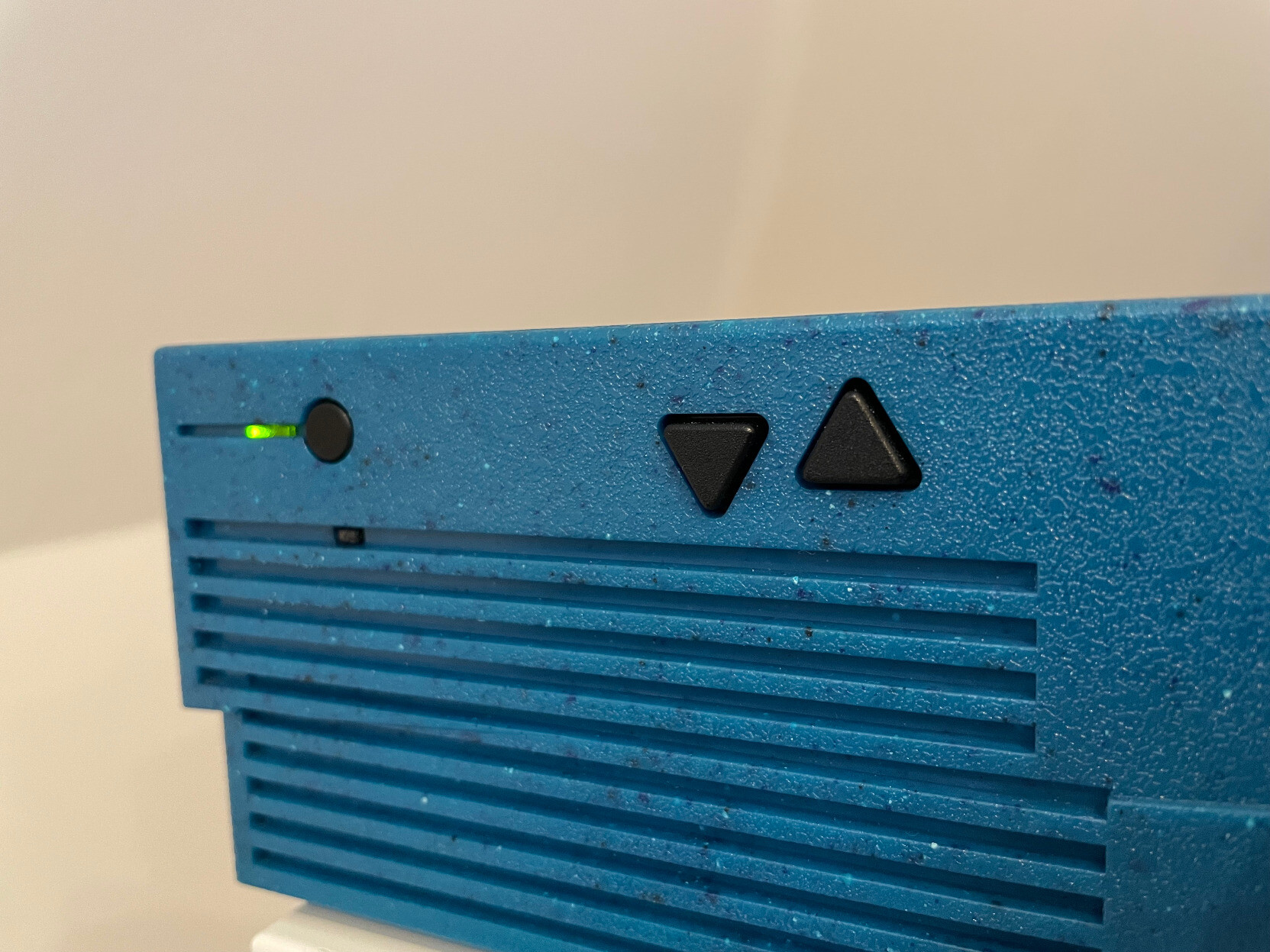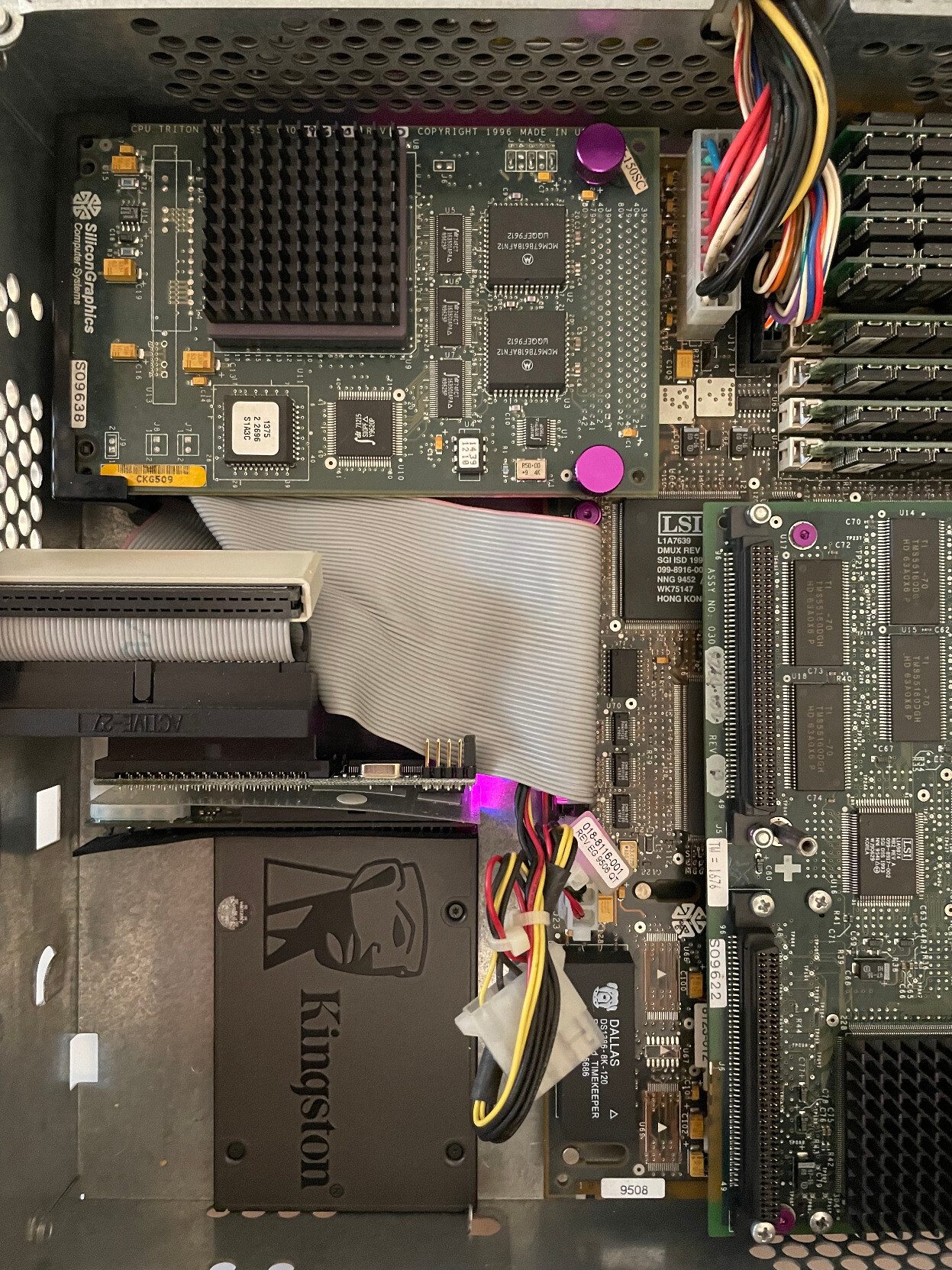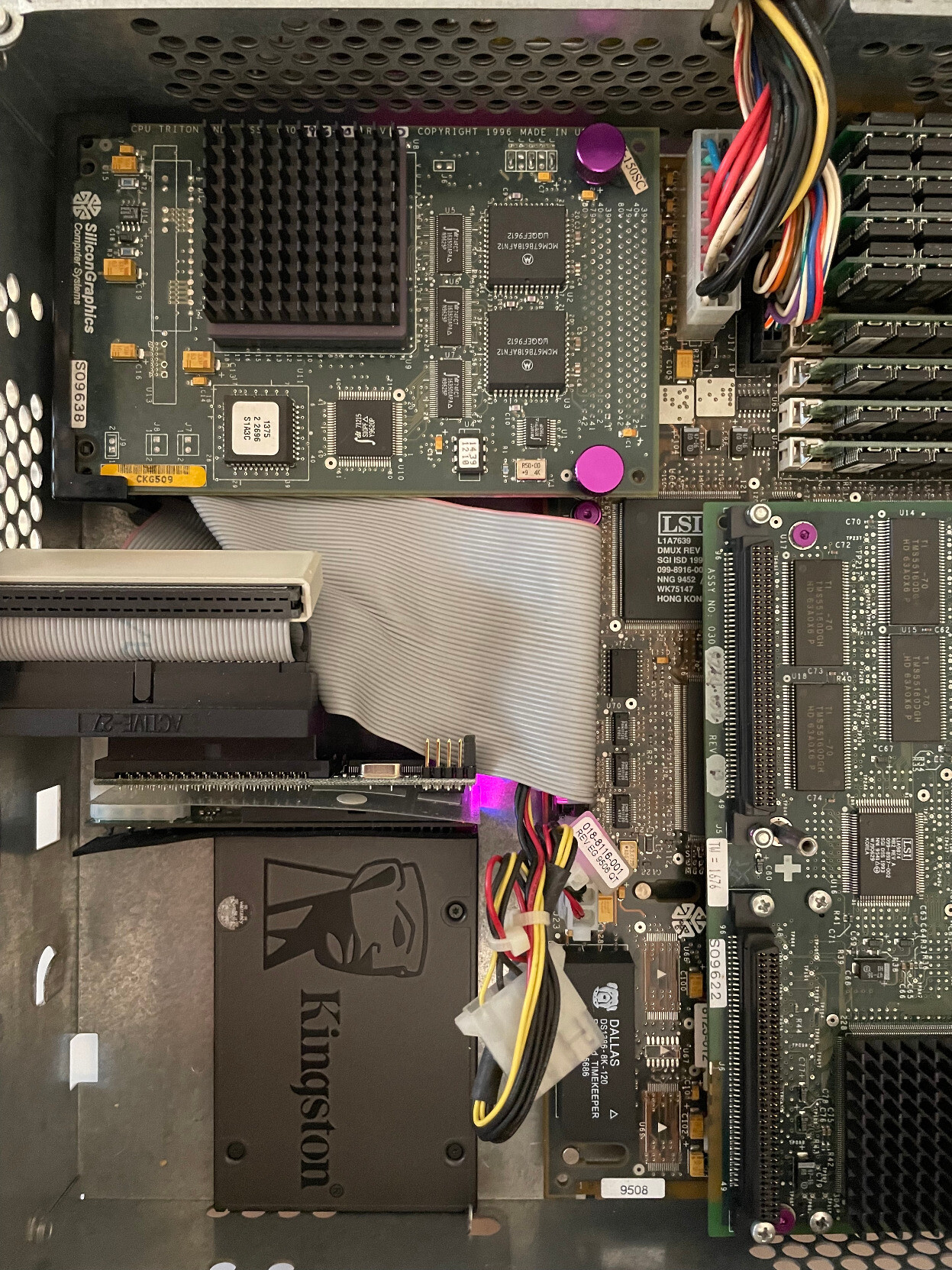The Indy is probably my favorite Silicon Graphics workstation of all times, even though it is comparatively slow and a lot less capable than its contemporaries (Indigo2) and successor (O2). I like it for two reasons: its classic “pizza-box” design is clean and well thought-through (it reminds me a lot of the early SPARCstations) and, more importantly, it is really quiet. If you ever had an Indigo2 or Octane sitting under your desk, you know how unbearably noisy their various fans can get. The Indy is different: a single large-diameter, temperature-controlled fan located in the PSU assembly is responsible for sucking air through the entire chassis, passing CPU heat sink and memory banks. It does that very quietly and at low load, the fan doesn’t run at all.
The Indy I own is one of the later models (circa 1996), with a 150 MHz QED R5000 SC processor with 512 Kbytes of secondary cache, 192 MBytes of RAM, and 24-bit XL graphics. I have also connected a 200 GB SATA3 Kington SSD via one of these rare ACARD AEC-7732U SCSI-to-IDE bridge adaptors, which makes the Indy eerily silent 🤫
Configuration Summary 🔗
| Component | Part Number | Revision |
|---|---|---|
| 150 Mhz R5000SC CPU Module | ||
| 24-bit XL (XGE) “Newport” graphics | 030-8264-002 | B |
Memory 🔗
The Indy has eight 72-pin RAM slots (two banks, each with four slots) for a minimum memory configuration of 32 and a maximum of 256 Mbytes. It requires fast-page-mode (FPM) SIMM modules with parity and 60 or 70ns cycle time.
Larger capacity parity FPM SIMMs are not easy to come by, especially not at a reasonable price point, but after skimming eBay for a couple of weeks (months?), I managed to upgrade the Indy to 192 Mbytes of total memory:
- Four 32 Mbyte modules: Samsung KMM5368100AG-7
- Four 16 Mbyte modules: Toshiba THM3640F0BSG-60
The Samsung chips are 70ns and the Toshiba chips are 60ns, but that doesn’t seem to be a problem - the system runs absolutely stable.
Graphics 🔗
There are three graphics options for the Indy: 8-bit XL “Newport”, 24-bit XL (XGE) “Newport”, and XZ “Elan”.
REX3 is the raster engine used on all Newport graphics boards and is the beginning of the graphics pipeline. There is no dedicated geometry engine, so all geometry calculations are done using the floating point unit of the systems processor. All Z buffering is done in the memory of the system.
24bit XL (XGED) graphics board (030-8264-002 Rev. B)
implement OpenGL 1.0 (plus SGI extensions).
None of the graphics options on the Indy support hardware texturing (quake: slow)
Each support a maximum resolution of 1280 × 1024 pixels[1] at a refresh rate of 76 Hz, and have a 13W3 SoG monitor connection.
Graphics options are connected to the system using a GIO32bis bus.
24-bit Newport XL graphics board (
SCSI Subsystem 🔗
The Indy has a single Fast SCSI (SCSI-2) controller based on the Western Digital 33C93B chipset. It supports up to 8 devices and data rates of up to 10 Mbyte/s (80 Mbit/s). For internal drives, the Indy has a 50-pin low-density and for extern devices, a 50-pin high-density (HD-50) connector.
I have connected a 200 GB SATA3 Kinston SSD to the internal SCSI port via an ACARD AEC-7732U SCSI-to-IDE bridge and another IDE to SATA 2.5 converter. This makes the Indy eerily quiet during normal operation, as the PSU fan kicks in only at high-loads. Peformance-wise, this setup gets close to the theoretical 10 Mbyte/s peak-performance of the Fast-SCSI bus:
/usr/sbin/diskperf -W -D -n "ACARD SCSI Bridge on Indy 5k" -c1g /tmp/testfile
#---------------------------------------------------------
# Disk Performance Test Results Generated By Diskperf V1.2
#
# Test name : ACARD SCSI Bridge on Indy 5k
# Test date : Sun Jan 22 14:17:47 2023
# Test machine : IRIX indy 6.5 10070055 IP22
# Test type : XFS data subvolume
# Test path : /tmp/testfile
# Request sizes : min=4096 max=4194304
# Parameters : direct=1 time=10 scale=1.000 delay=0.000
# XFS file size : 1073741824 bytes
#---------------------------------------------------------
# req_size fwd_wt fwd_rd bwd_wt bwd_rd rnd_wt rnd_rd
# (bytes) (MB/s) (MB/s) (MB/s) (MB/s) (MB/s) (MB/s)
#---------------------------------------------------------
4096 2.85 2.74 2.85 2.75 2.85 2.65
8192 4.01 4.00 4.00 3.84 4.01 3.73
16384 5.36 5.31 5.36 5.14 5.34 5.03
32768 6.43 6.37 6.42 6.17 6.43 6.09
65536 7.30 7.07 7.32 6.93 7.31 6.87
131072 7.87 7.49 7.86 7.42 7.88 7.37
262144 8.12 7.59 8.12 7.53 8.13 7.50
524288 8.41 8.07 8.41 8.01 8.41 7.98
1048576 8.64 8.37 8.64 8.31 8.64 8.30
2097152 8.77 8.52 8.77 8.46 8.76 8.46
4194304 8.82 8.60 8.83 8.56 8.82 8.56
Ports
- 2 x RS232 serial port connectors (DIN-8 female)


